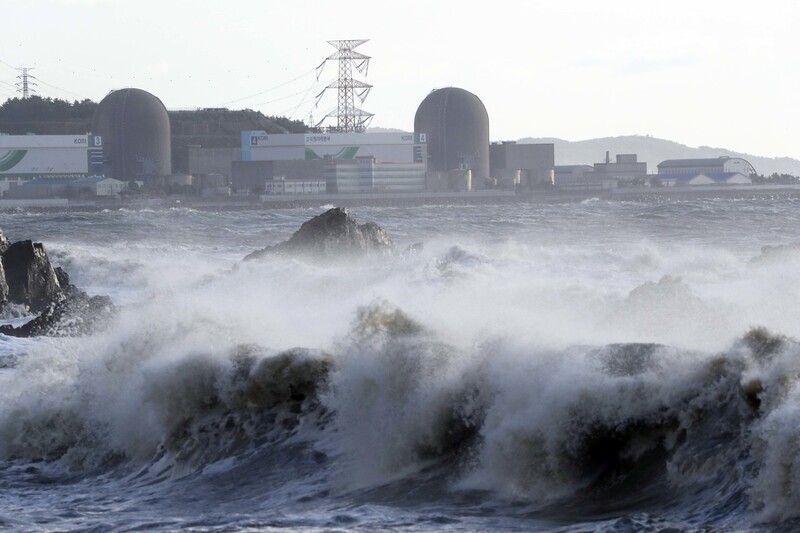hankyoreh
Links to other country sites 다른 나라 사이트 링크
Busan’s Kori Nuclear Power Plant loses power due to Typhoon Maysak

As South Korea braced for the impact of Typhoon Maysak, the ninth typhoon of the season, four reactors at the Kori Nuclear Power Plant were suspended, raising concerns about the risk of nuclear reactors during the oncoming climate crisis, when extreme weather events will happen with greater frequency.
Korea’s Nuclear Safety and Security Commission (NSSC) announced on Thursday that four reactors at Kori Nuclear Power Plant, in Gijang County, administered by the metropolitan city of Busan, had been automatically shut down because of issues with power transmission lines. New Kori No. 1 halted operations at 0:59 am, New Kori No. 2 at 1:12 am, Kori No. 3 at 2:53 am, and Kori No. 4 at 3:01 am.
The NSSC also said that when external power was cut off to Kori No. 1, which has been permanently shuttered, and Kori No. 2, which is currently offline for repairs, emergency diesel generators had automatically come online at 2:24 am and 3:30 am, respectively. Prior to the automatic shutdown, the four reactors had been providing 4.13 million kilowatts of power, accounting for 7% of the country’s total power demand of 59 million kilowatts.
The central control center at the Korea Power Exchange (KPX) reportedly responded to the sudden shortage of electricity by activating pumped-storage hydropower plants and hydroelectric plants, restoring balance to the power supply. This was possible because the authorities had already set aside reserve capacity as a contingency measure against the oncoming typhoon. The staggered suspension of generation at the reactors also gave the authorities time to take countermeasures.
If 2 or more reactors had shut down simultaneously, entire power grid would have destabilizedBut if two or more nuclear reactors had shut down simultaneously on a day when solar generators were running, things could have played out much differently, according to electric power experts.
“If that happened, line frequency in the power grid would plummet, potentially destabilizing solar power generators and creating a cascade of disconnections from the grid,” said Jeon Yeong-hwan, a professor of electronic and electrical engineering at Hongik University.
Because nuclear reactors produce so much power — 1 gigawatt each — their sudden suspension would destabilize the entire electrical grid. That could also lead to the interruption of power from solar generators and, in turn, large-scale blackouts.
Solar power generators typically have converters that turn the direct current they produce into the alternating current required by the power grid. But when the grid itself becomes unstable, those generators are equipped to disconnect themselves from the grid as a protective measure.
Need to increase share of renewable energy in response to climate changeSince Korea will have to greatly increase its share of new and renewable energy as part of its response to climate change, nuclear reactors with massive output could themselves become a problem. That issue has been repeatedly raised by experts from the Korean Institute of Electrical Engineers (KIEE) and other organizations.
“Large clusters of nuclear reactors aren’t suitable for the unusual weather that we’re going to see in the era of climate change. Decentralization is even more important in terms of grid stability,” Jeon said.
“The Fukushima accident and this recent shutdown at the Kori Nuclear Power Plant leave no doubt that nuclear reactors are not an option, but only a threat, in the era of climate change. We need to be preparing countermeasures for the possible interruption of the huge amount of power generated by these reactors,” said a spokesperson for the Korea Federation for Environmental Movements.
By Kim Jeong-su, senior staff writer
Please direct comments or questions to [english@hani.co.kr]

Editorial・opinion
![[Column] Park Geun-hye déjà vu in Yoon Suk-yeol [Column] Park Geun-hye déjà vu in Yoon Suk-yeol](https://flexible.img.hani.co.kr/flexible/normal/500/300/imgdb/original/2024/0424/651713945113788.jpg) [Column] Park Geun-hye déjà vu in Yoon Suk-yeol
[Column] Park Geun-hye déjà vu in Yoon Suk-yeol![[Editorial] New weight of N. Korea’s nuclear threats makes dialogue all the more urgent [Editorial] New weight of N. Korea’s nuclear threats makes dialogue all the more urgent](https://flexible.img.hani.co.kr/flexible/normal/500/300/imgdb/original/2024/0424/7317139454662664.jpg) [Editorial] New weight of N. Korea’s nuclear threats makes dialogue all the more urgent
[Editorial] New weight of N. Korea’s nuclear threats makes dialogue all the more urgent- [Guest essay] The real reason Korea’s new right wants to dub Rhee a founding father
- [Column] ‘Choson’: Is it time we start referring to N. Korea in its own terms?
- [Editorial] Japan’s rewriting of history with Korea has gone too far
- [Column] The president’s questionable capacity for dialogue
- [Column] Are chaebol firms just pizza pies for families to divvy up as they please?
- [Column] Has Korea, too, crossed the Rubicon on China?
- [Correspondent’s column] In Japan’s alliance with US, echoes of its past alliances with UK
- [Editorial] Does Yoon think the Korean public is wrong?
Most viewed articles
- 1‘We must say no’: Seoul defense chief on Korean, USFK involvement in hypothetical Taiwan crisis
- 2‘Weddingflation’ breaks the bank for Korean couples-to-be
- 3[Reportage] On US campuses, student risk arrest as they call for divestment from Israel
- 4[Column] Park Geun-hye déjà vu in Yoon Suk-yeol
- 5Amnesty notes ‘erosion’ of freedom of expression in Korea in annual human rights report
- 6Korea sees more deaths than births for 52nd consecutive month in February
- 7N. Korean delegation’s trip to Iran shows how Pyongyang is leveraging ties with Moscow
- 8Will NewJeans end up collateral damage in internal feud at K-pop juggernaut Hybe?
- 9[Guest essay] The real reason Korea’s new right wants to dub Rhee a founding father
- 10N. Korean hackers breached 10 defense contractors in South for months, police say